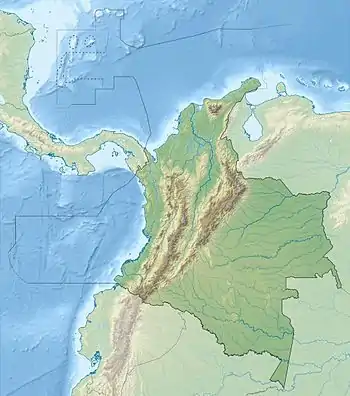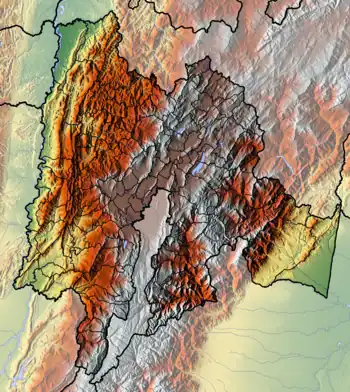    | |
| UTC time | 2023-08-17 17:04:59 |
|---|---|
| 2023-08-17 17:17:18 | |
| USGS-ANSS | ComCat |
| ComCat | |
| Local date | 17 August 2023 |
| Local time | 12:04 (UTC-5) |
| 12:17 (UTC-5) | |
| Magnitude | 6.1 Mw |
| 5.6 Mw | |
| Depth | 10 km (6 mi) |
| Epicenter | 4°21′N 73°35′W / 4.35°N 73.59°W |
| Areas affected | Colombia, Venezuela |
| Max. intensity | VIII (Severe) |
| Aftershocks | 64 (as of 18 August)[1] Largest is Mw 5.0[2] |
| Casualties | 2 dead, 50 injured[1][3] |
A earthquake with a moment magnitude of 6.1 and its aftershocks affected the El Calvario Capital-Cordillera subregion (Villavicencio, Restrepo, Cumaral, San Juanito) and Medina province (Medina, Paratebueno), on 17 August 2023.[4][5]
Tectonic setting
Subduction of the Nazca Plate beneath the North Andes Plate (part of the South American Plate) occasionally produces moderately large to great earthquakes along the coast of Colombia. The megathrust fault forms the northern part of the Peru–Chile Trench, which has been the source of very large earthquakes including the 1906 Ecuador–Colombia earthquake; the magnitude 8.8 tremor is the biggest in the region and the sixth largest earthquake to be instrumentally recorded.
The North Andes Plate moves northeastwards relative to the South American Plate at a rate of 8.6 mm per year. This motion is partitioned into motion parallel to the plate boundary (right lateral strike-slip) of 8.1 mm per year and 4.3 mm per year perpendicular to the boundary in the form of shortening. The boundary is formed by the Eastern Frontal Fault System, which consists of both thrust faults and oblique-slip faults that together take up this displacement.[6] This boundary has been associated with many damaging historical earthquakes, such as the 1967 Neiva and the 2008 El Calvario earthquakes.[7][8]
Earthquake
The location of the first earthquake was in El Calvario, in the department of Meta, 70 km (43 mi) southeast of the country's capital, Bogotá. The depth of the earthquakes were about 10 km (6.2 mi) beneath the surface.[4]
Tremors from the earthquakes were strongly felt in Bogotá, with a Modified Mercalli intensity of V (Moderate) reported there.[4]
Impact
Damage and casualties
At least five of Colombia's departments were affected by the earthquake.[1] In total, at least 20 houses collapsed and 252 others were damaged across the country; damage was reported as far away as Armenia, in Quindío Department.[9] Two people were killed as a result of the earthquake; a woman in Bogotá after jumping from a building and a man after an earthquake-related incident in a mine near Sativanorte.[10][11] Both were Venezuelan nationals.[12][13] A total of six buildings collapsed and 154 others were damaged in Meta,[14][15] while 44 buildings were affected in Cundinamarca, including one that collapsed.[16] Several buildings and a church were also damaged in Boyacá.[17]
In Gachalá, at least 88 houses were affected, including 12 that collapsed; a church and a fire station were also affected. Two people were injured there.[18][3] The facade of a building collapsed in Guayabetal.[16] Some houses were destroyed and four others partially collapsed in El Calvario, where several students were hospitalized.[18] In Cáqueza, one person was injured and 26 students were hospitalized due to shock, and three houses, the municipal building and a market were damaged.[3] In Sibate, the city hall was damaged and 15 students were hospitalized due to panic.[3] One person in Soacha was injured by a wall collapse and another was hospitalized due to panic.[3] In Sativanorte, another mining incident caused by the earthquake caused one injury.[11] Four minors were also injured, three of them in Meta and another in Boyacá.[1]
Sixty-three buildings and the courthouse in Villavicencio was damaged and windows were broken in several buildings in the city.[15][19] In Bogotá, at least 178 buildings were damaged.[10] Among them was one of the buildings housing the Congress of Colombia, where parts of the roof fell.[16] In Zulia, Venezuela, a church collapsed.[20]
Estimations of losses
The United States Geological Survey's PAGER service estimates included an orange-alert level, reporting there was a 93% chance that the earthquake could cause damage between US$1 million and US$10 billion. It also said the earthquake had a 76% of causing between one and 1,000 fatalities.[4]
For the second earthquake, the USGS issued an orange-alert and estimated an 82% chance that it would cause between one and 1,000 fatalities, as well as a 95% of it causing between US$1 million and US$10 billion worth of damage.[5]
See also
References
- 1 2 3 4 "Temblor en Colombia se sintió en Bogotá y otras ciudades: van 41 réplicas". www.eltiempo.com. 17 August 2023. Retrieved 18 August 2023.
- ↑ "M 5.0 - 7 km N of Cumaral, Colombia". United States Geological Survey. 18 August 2023. Retrieved 18 August 2023.
- 1 2 3 4 5 "Daños en Cundinamarca por el sismo del jueves en Colombia". Periodismo Publico. 18 August 2023. Retrieved 18 August 2023.
- 1 2 3 4 "M 6.1 - 10 km NNW of Cumaral, Colombia". United States Geological Survey. 17 August 2023. Retrieved 17 August 2023.
- 1 2 "M 5.6 - 2 km E of Restrepo, Colombia". United States Geological Survey. 17 August 2023. Retrieved 17 August 2023.
- ↑ Mora-Páez, H.; Kellogg, J.N.; Freymueller, J.T.; Mencin, D.; Fernandes, R.M.S.; Diederix, H.; LaFemina, P.; Cardona-Piedrahita, L.; LIzarazo, S.; Peláez-Gaviria, J.-R.; Díaz-Mila, F.; Bohórquez-Orozco, O.; Giraldo-Londoño, L.; Corchuelo-Cuervo, Y. (2019). "Crustal deformation in the northern Andes – A new GPS velocity field". Journal of South American Earth Sciences. 89: 76–91. Bibcode:2019JSAES..89...76M. doi:10.1016/j.jsames.2018.11.002. S2CID 135152742.
- ↑ Dimaté, C.; Rivera, L.; Cisternas, A. (2005). "Re-visiting large historical earthquakes in the Colombian Eastern Cordillera". Journal of Seismology. 9 (1): 1–22. Bibcode:2005JSeis...9....1D. doi:10.1007/s10950-005-1413-2. hdl:20.500.11850/33443. S2CID 128620783.
- ↑ Dicelis, G.; Assumpção, M.; Kellogg, J.; Pedraza, P.; Dias, F. (2016). "Estimating the 2008 Quetame (Colombia) earthquake source parameters from seismic data and InSAR measurements". Journal of South American Earth Sciences. 72: 250–265. Bibcode:2016JSAES..72..250D. doi:10.1016/j.jsames.2016.09.011.
- ↑ "UNGRD actualiza reportes de afectación por sismos presentados en el centro del país". portal.gestiondelriesgo.gov.co. 18 August 2023. Retrieved 18 August 2023.
- 1 2 "El relato de un habitante del epicentro: 'El primer temblor me mandó al suelo'". www.eltiempo.com. 18 August 2023. Retrieved 18 August 2023.
- 1 2 "Autoridades de Boyacá confirmaron la muerte de una persona, por una emergencia que estaría relacionada con los sismos de este jueves". El País. 17 August 2023. Retrieved 17 August 2023.
- ↑ "Accidente minero cobró la vida de una persona tras los sismos que afectaron a Colombia". www.infobae.com. 18 August 2023. Retrieved 19 August 2023.
- ↑ "Mujer que murió en Bogotá durante el sismo era venezolana y tenía 26 años". efectococuyo.com. 19 August 2023. Retrieved 19 August 2023.
- ↑ "El Calvario resistió al temblor y su alcalde dio buenas noticias: "No hubo lesionados, gracias a Dios"". www.noticiasrcn.com. 18 August 2023. Retrieved 18 August 2023.
- 1 2 "Varios edificios reportaron daños estructurales por los sismos". www.villavicenciodiaadia.com. 18 August 2023. Retrieved 18 August 2023.
- 1 2 3 "Fuerte temblor hoy en Colombia: imágenes de destrucción tras el sismo". Infobae. 17 August 2023. Retrieved 17 August 2023.
- ↑ "Balance de daños del temblor que se registró en el centro del país". www.portafolio.co. 18 August 2023. Retrieved 18 August 2023.
- 1 2 "Primeras imágenes de El Calvario, Meta, epicentro del fuerte temblor en Colombia". Caracol Televisión. 17 August 2023. Retrieved 17 August 2023.
- ↑ "Imágenes del temblor en Colombia: así quedó el Palacio de Justicia en Villavicencio". El Tiempo. 17 August 2023. Retrieved 17 August 2023.
- ↑ "Mujer muere al lanzarse desde séptimo piso durante sismo de 6.1 en Colombia; así se vivió el siniestro". www.reporteindigo.com. 17 August 2023. Retrieved 18 August 2023.